Cressi Leonardo vs. Suunto Zoop Novo
Comparing the Suunto Zoop Novo with the Cressi Leonardo
Both the Cressi Leonardo and the Suunto Zoop Novo are dive computers designed for the beginner diver. They are affordable and provide a set of capabilities that matches the entry-level diver.
When we talk about ‘limited’ functionality then please know that many divers will never need more capabilities as any of these two dive computers offer. Will there be things you might miss if you have dived over 100 dives? Yes, but even then it won’t be essential to have those capabilities in most cases
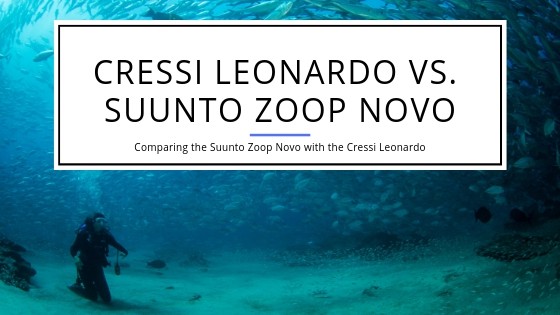
At first glance both dive computers are not that different. They both come with large screens which makes them too large to use and wear as a day-to-day watch.
Functionality Differences
The first difference you will see is that the navigation on the Cressi Leonardo uses a single button. The Suunto Zoop Novo features four buttons to navigate through the functions.
Both approaches have their advantages and disadvantages. The upside of a single button navigation is that it’s super-easy to use and that you can’t confuse any buttons when you dive with gloves. The downside is that you have to step through all menu items to get to where you want to get.
Using multiple buttons to navigate allows you to reach certain menu selections faster as you don’t have to step through all of them. However, you have to memorize which button does what and if the buttons are too close together, you can easily confuse them or not be able to touch the right one if you wear thicker gloves. The Suunto Zoop Novo features a good compromise in this area as the buttons are spaced very far apart so you won’t press the wrong button by accident.
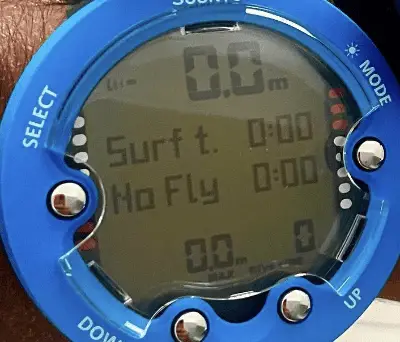
While the navigation has differences by how many buttons you have to use, the overall functionality of both dive computers is not that different. Both offer the basic features you will need to dive safely.
They both can handle Air, Nitrox and Gauge modes. The Suunto Zoop can also handle free diving and has an off mode. This can be helpful if you hit the water but don’t want it to measure any time or depth which would impact your next dive.
One feature that the Leonardo has which is helpful for dive shops is that you can reset the dive computer. This allows dive shops and dive schools to have the dive computer start fresh for every new diver.
When you use the Leonardo as your dive computer then do not reset the device. To calculate the correct and safe times for your dives, it requires having information about your previous dives available. If you reset between two dives to gain more time underwater, you can risk your health!
The Zoop Novo only comes as a wrist dive computer. The Leonardo is available as a personal wrist dive computer and a console. It comes in two different console setups. One with a pressure gauge and the other with a compass.
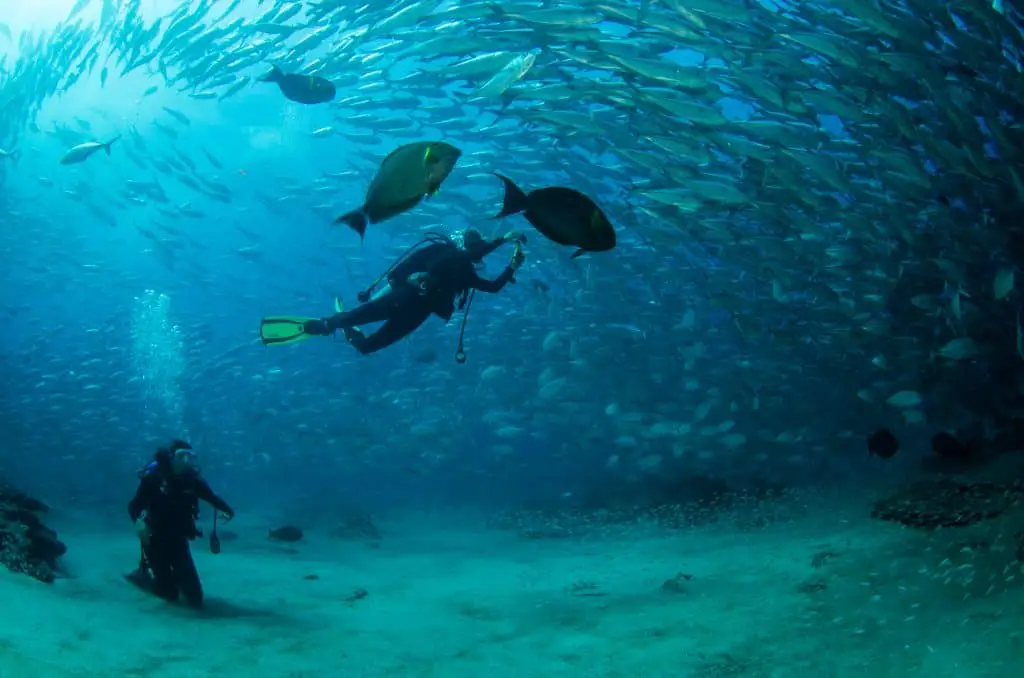
The logbook on the Suunto Zoop is larger which means you can store more dive data on the device itself. Both scuba computers are capable to connect to a PC or Mac to transfer the data off of the device. You can then analyze and store the data on your PC. You can also plan future dives based on those historic records.
If you dive a lot and want to share your dive data with your friends and family, then the Suunto offers the better features for that. You can upload the data from your dives to the Suunto Movescount portal where you can add pictures, video and geo-location. This allows you to create a multi-media scrapbook of your dives and share it with the world!
Nitrox Handling and Sophisticated Functions
Both dive computers can handle Nitrox up to 50%. They are, as is to be expected with an entry-level model, not capable to switch gases during a dive. More sophisticated capabilities like these can be found on higher end devices.
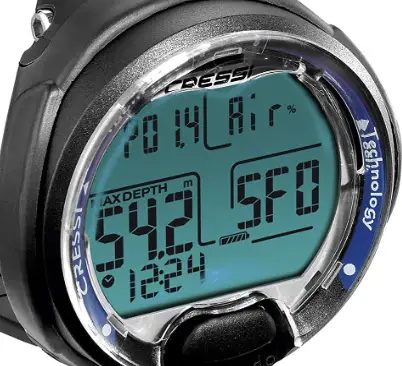
Both dive computers use an RGBM model for their calculations. The Zoop Novo uses the Suunto own RGBM while the Leonardo is using the Cressi RGBM. Overall, the Cressi algorithm is a little more liberal while the Suunto is more on the conservative side. It’s hard to say what is better. The one thing you want to keep in mind is that if you for example use a Leonardo and your dive buddy uses a Zoop Novo then the Suunto algorithm might require a deco stop while the Leonardo does not (yet).
Reset Capability
As already mentioned, the Cressi Leonardo offers the ability to do a complete reset. This makes it a great device for dive schools and dive shops that rent out equipment. The reset will erase all data from previous dives and all calculations will start with no consideration of the past.
Other than being an advantage for this specific use case, there’s no advantage if you own the dive computer and use it as your personal scuba watch. In that case it can be problematic if you reset the device to have it ignore previous dives. You can endanger yourself and your buddy/buddies if you do that!
Missing Capabilities
Neither of them has air integration capabilities or a digital compass built-in. That is not a problem for beginners and divers that don’t dive too often.
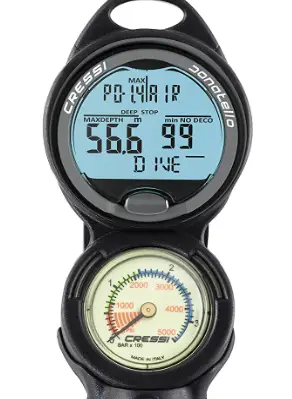
The lack of more sophisticated features doesn’t allow either of these devices to grow with your experience. This does not mean though that you will need more features anytime soon if you start to dive. You should easily be able to dive for a few hundred hours before you reach the point that you would require more functionalities. Even then you can use either of these dive computers as a backup to a higher end model.
If you want more information and detailed reviews of both devices, then check out our in-depth reviews. We have a closer look at the Cressi Leonardo here where you can find out all the details you need to know about this model. If the Suunto Zoop Novo is more of interest to you, then have a look at our in-depth review that you can find by clicking on this link.
If you want to check out how the Leonardo compares to the Cressi Giotto, then check out this post where we highlight the differences between those two dive computers. We also had a closer look at the differences between the Zoop Novo and its predecessor the Zoop.
The Zoop Novo is a good entry level dive computer. The next level up in Suunto’s lineup is the Vyper Novo. You can get an overview of the differences between these two devices in this comparison. One of the major differences when looking at any more sophisticated models is that they will offer functions to track your air consumption among other higher-end features.
Verdict
Either of these dive computers is a great choice for an entry-level diver or if you dive only a few times a year. There’s no need to think of a device with more features that costs more.
If you are beginning to dive and you think you might end up diving a lot, it still would make sense to start with an entry-level device such as the Suunto Zoop Novo or the Leonardo Cressi. Most divers that do not live close to the water will need quite a while before they gain the experience to outgrow the capabilities of either of these two devices.
Both dive computers use a rather conservative algorithm. Some divers complain about that, but reality is that these devices make sure you stay safe underwater. For beginners it should not be a problem. If you upgrade to a more sophisticated dive computer at a later point in time you might think of going for a model that has a less conservative algorithm like for example the ones from Oceanic.
It rarely makes sense to buy a more high-end model right at the start. When a beginner gained enough experience to look the next level of dive computers, they will by then possibly have additional features that today’s models don’t have. Get the latest model of these more sophisticated scuba computers when you need one and keep your entry-level device as a backup.
If you are looking for other dive computers, then check out our buying guide and list of recommended devices. We update these recommendations regularly as there are new dive computers entering the market all the time that offer better features or are easier to use.
